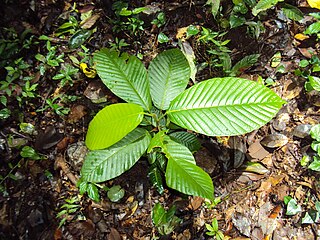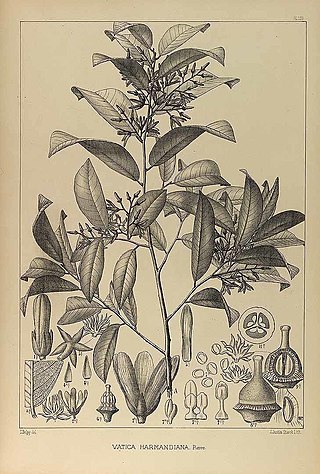
Dipterocarpaceae is a family of flowering plants with 22 genera and about 695 known species of mainly lowland tropical forest trees. Their distribution is pantropical, from northern South America to Africa, the Seychelles, India, Indochina, Indonesia, Malaysia and Philippines. The greatest diversity of Dipterocarpaceae occurs in Borneo.

Dipterocarpus is a genus of flowering plants and the type genus of family Dipterocarpaceae.

Parashorea is a genus of plant in family Dipterocarpaceae. The name Parashorea is derived from Greek and refers to the genus similarity to Shorea. It contains about 14 species distributed from South Myanmar, Thailand, Indo-China and the southernmost parts of China to Sumatra, Borneo and the Philippines.
Shorea argentifolia is an emergent rainforest tree species in the family Dipterocarpaceae. It native to Borneo. It grows in mixed dipterocarp forests on hills and ridges, up to 900 metres elevation. The species is threatened by habitat loss. The tallest recorded specimen is 84.9 m tall in the Tawau Hills National Park, in Sabah.
Anthoshorea hypochra called, along with some other species in the genus Anthoshorea, white meranti, is a species of tree in the family Dipterocarpaceae. It grows naturally in Cambodia, Sumatra, Laos, Peninsular Malaysia, Thailand, and Vietnam.
Neohopea isoptera is a species of flowering plant in the family Dipterocarpaceae. It is the sole species in genus Neohopea. It is a tree endemic to Borneo. It is native to lowland mixed dipterocarp forest up to 500 meters elevation, where it is a canopy tree growing up to 60 meters tall.
Richetia kudatensis is a species of tree in the family Dipterocarpaceae. It is endemic to Borneo, in low coastal hills of the north and west of Malaysian Sabah.

Shorea leprosula is a species of tree in the family Dipterocarpaceae. It is native to Sumatra, Borneo, Peninsular Malaysia, Java, and Thailand.
Shorea superba is a species of plant in the family Dipterocarpaceae. The species name is derived from Latin and refers to the stature and elegance of the tree.

Vatica harmandiana, also known by the synonym Vatica cinerea, is a species of plant in the family Dipterocarpaceae. It is a smallish tree native to Southeast Asia. It is the most common plant species in certain types of mature woodland habitat within its range and is furthermore common in disturbed secondary forests covering much of its range, nonetheless it was considered, along with most Dipterocarpaceae, to be endangered by the IUCN between 1998 and 2017. It is usually not commercially harvested except for local use.
Parashorea tomentella is a species of plant in the family Dipterocarpaceae. It is endemic to eastern Borneo. It is a large emergent tree, up to 65 m tall, found in lowland dipterocarp forests on fertile clay soils. It is a light hardwood sold under the trade names of White Lauan or White Seraya. It is found in forest reserves on the east coast of Sabah.
Anthoshorea ochracea is a species of plant in the family Dipterocarpaceae. The species name is derived from Latin and refers to the colour of the undersurface of the leaf. A. ochracea is endemic to Borneo.
Shorea atrinervosa is a species of plant in the family Dipterocarpaceae. The species name is derived from Latin and refers to leaf venation which is black in herbarium specimens.
Shorea calcicola is a species of plant in the family Dipterocarpaceae. It is endemic to Borneo. The species name is derived from Latin and refers to the preferred habitat of this species. It is a medium-sized tree, usually less than 50 metres (160 ft) tall, found in mixed dipterocarp forest on organic soils over limestone.
Shorea parvifolia is a species of tree in the family Dipterocarpaceae, commonly known as light red meranti and white lauan. It is native to tropical southeastern Asia.
Shorea parvistipulata, locally known as kawang daun merah, is a species of tree in the family Dipterocarpaceae. It is endemic to Borneo, where it is widespread in lowland and hill rain forests.
Rubroshorea is a genus of flowering plants in the family Dipterocarpaceae. It includes 71 species of trees native to Malesia and the Caroline Islands.

Anthoshorea javanica is a species of flowering plant in the family Dipterocarpaceae. It is a tree native to southern Sumatra and Java in Indonesia. It is one of several dipterocarp species commonly known as white meranti.

Rubroshorea ovalis is a species of flowering plant in the family Dipterocarpaceae. It is a large fast-growing tree, up to 50 meters tall, which is native to Borneo, Sumatra, Peninsular Malaysia, and Singapore. It flowers every 3 to 4 years between March and June. Flowers are pollinated by insects and seeds are dispersed by the wind.








